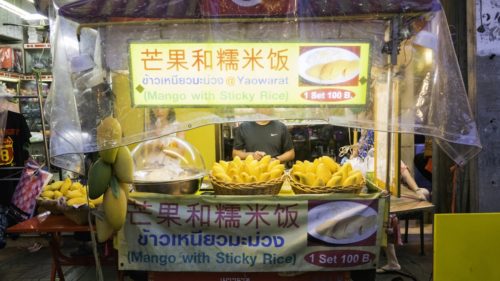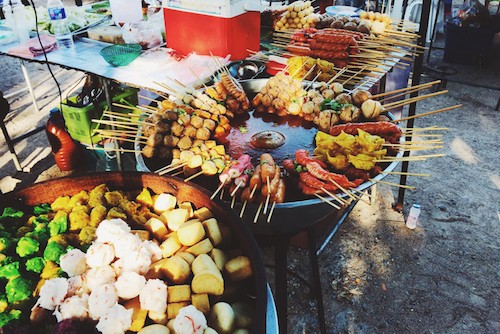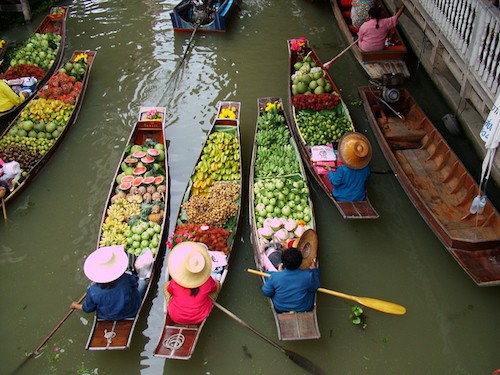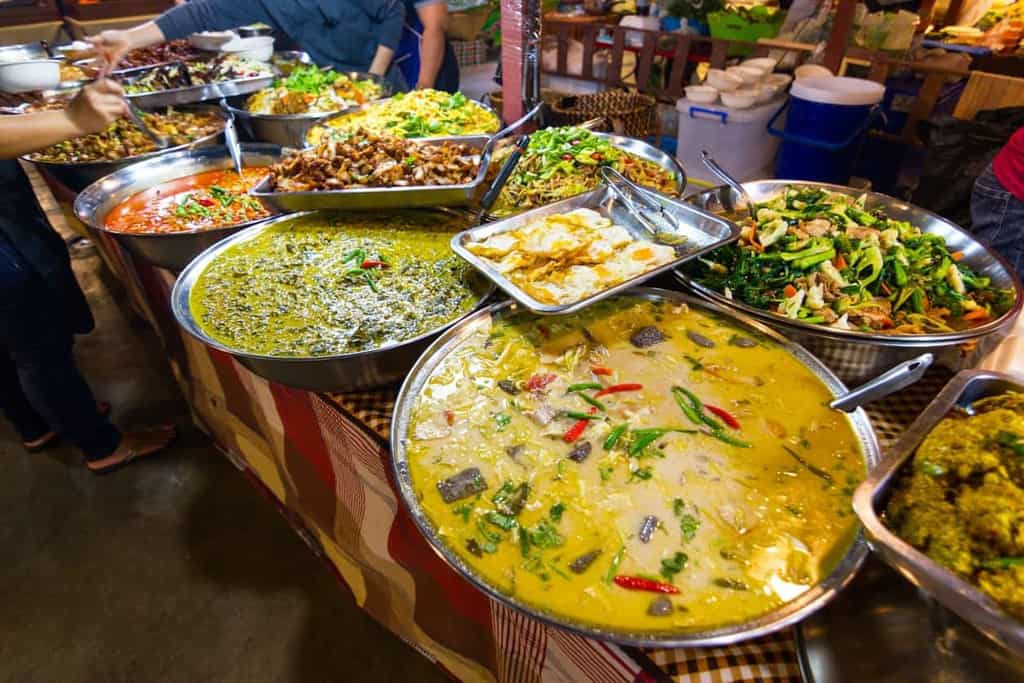Sampling street food can be intimidating in any foreign country. You may not speak the local language, or even know what you’re about to eat! But Bangkok has some of the most famous street food in the world, and no visit to the Thai capital is complete without trying some. Although the city’s many street food stalls may seem overwhelming, it’s actually an exciting scene to navigate. With these simple tips, you can maximize your eating adventures in Bangkok while staying healthy (and full).
How to Navigate Bangkok’s Street Food & Culinary Scene

Do a Street Food Tour
Tours make street food seem infinitely more approachable. In fact, it may be best to start with a tour so you can take everything you’ve learned and later venture out on your own to sample street food with your newfound foodie knowledge.
Embark on a captivating journey through Bangkok’s history and heritage with this private, half-day tour to bustling neighborhoods, vibrant markets, and one of Thailand’s most revered temples. Stroll through the quaint lanes of ancient Chinatown before plunging into the mesmerizing sights and scents of the sprawling Pak Khlong flower market, where skilled vendors craft intricate sculptures from delicate blossoms. Wander the sun-drenched halls of Wat Suthat, in the company of monks who lovingly maintain the temple’s majestic chedis and rows of elegant Buddhas.
This exclusive tour offers exceptional value for money, ensuring a personalized experience with your very own private guide. You’ll enjoy the convenience of hotel pickup and the intimacy of a private tour, operating solely for your party and accompanied by a knowledgeable guide/driver. Immerse yourself in Bangkok’s rich cultural tapestry and create unforgettable memories on this remarkable adventure.
Secret Food Tours also offers a fun experience, which ends at a unique, secret bar after a tour through Chinatown.
Where to Find the Most Famous Street Food in Bangkok
From the lively, neon-lit lanes of Chinatown to the energetic buzz of Khao San Road, Bangkok’s famous street food hotspots offer a mouthwatering array of dishes that will satisfy every craving. Whether you’re savoring succulent grilled meats at Victory Monument or indulging in the sweet delights of mango sticky rice at Silom Soi 20, each location promises an unforgettable gastronomic experience. So, get ready to ignite your taste buds and immerse yourself in the irresistible flavors of Bangkok’s street food scene.
Yaowarat Road (Chinatown)
Known for its bustling atmosphere and diverse culinary offerings, Bangkok’s Chinatown is a must-visit for street food enthusiasts. Yaowarat Road comes alive at night, with vendors lining the streets, offering everything from noodle dishes to seafood and desserts.
Khao San Road
A backpacker’s haven, Khao San Road is famous for its lively nightlife and street food options. Here, you’ll find vendors selling classic Thai dishes, grilled meats, exotic fruits, and even international fare like burgers and pizzas.
Ratchawat Market and Sriyan Market
These local markets in the Dusit area are popular among foodies for their authentic and affordable street food options. You’ll find an array of Thai dishes, including noodle soups, grilled meats, and traditional desserts.
Victory Monument
The area around Victory Monument is known for its street food vendors offering a variety of local dishes. Here, you can find popular options like boat noodles, Thai-style fried chicken, and the much-loved mango sticky rice.
Silom Soi 20
A popular spot for office workers during lunchtime, Silom Soi 20 offers a wide range of Thai street food options, including curries, grilled meats, and stir-fried dishes.
Ratchada Rot Fai Train Night Market
This vibrant night market is not only a great place to shop for unique items, but it also boasts a fantastic street food scene. You can find an assortment of dishes, from classic Thai cuisine to seafood barbecues and international fusion food.
Chatuchak Weekend Market
One of the largest markets in the world, Chatuchak Weekend Market is home to a vast array of food vendors offering both traditional Thai dishes and international cuisine. It’s a perfect spot to grab a bite while exploring the endless array of stalls.
Visit These Streets Outside of Chinatown
It’s no secret that Bangkok’s Chinatown has some of the most authentic street food, but it may be a little intimidating for a first-timer. Ease in by stopping first at Silom Road, Charoen Krung Road or Soi 38 — these areas tend to be a little more manageable.
Night markets, like JJ Green or the fancy Asiatique are also excellent spots to sample street food. Although they may be a little more touristy, vendors may speak more English and can help explain the dishes to you.
If you’re unsure about where to start, definitely consider taking one of the above-mentioned Bangkok street food tours. Between the expertise of a local and the ease of transport via private Tuk Tuk, you can’t really go wrong.
Do Your Homework
Most of the time, I don’t ask what’s in it, I just order it! But those with restricted diets may want to be aware of what they are eating. Some of the most famous and popular dishes to order beyond Pad Thai are:
- Ba Mee: A comforting bowl of Thai wonton noodles with pork, Ba Mee features egg noodles served in a rich, savory broth. Tender slices of barbecued or braised pork, along with delicate wontons filled with minced pork, are added to the mix. Topped with leafy greens and a sprinkle of fried garlic, Ba Mee is a hearty and satisfying meal.
- Khao Man Gai: Thai chicken rice, or Khao Man Gai, is a simple yet flavorsome dish. Succulent, poached chicken is served alongside fragrant jasmine rice cooked in chicken broth and infused with garlic and ginger. The dish is often accompanied by a tangy dipping sauce made from soybean paste, ginger, garlic, and chili, which adds an extra layer of depth to the meal.
- Tom Yum Goong: A fiery and aromatic concoction, Tom Yum Goong is a spicy jumbo prawn soup that packs a punch. The dish features plump, juicy prawns cooked in a flavorful broth infused with lemongrass, kaffir lime leaves, galangal, and fiery bird’s eye chilies. Finished with a splash of lime juice and fish sauce, this soup is an explosion of bold flavors.
- Gai Tod: A popular street food snack, Gai Tod is Thai-style fried chicken. Pieces of chicken are marinated in a blend of herbs and spices, then coated in a light, crispy batter and deep-fried to perfection. Gai Tod can be enjoyed on its own, with sticky rice, or dipped in a sweet and spicy sauce.
- Moo Ping: A quintessential street food favorite, Moo Ping consists of juicy, marinated pork skewered on bamboo sticks and grilled over charcoal. The marinade often includes ingredients like soy sauce, fish sauce, garlic, and sugar, which caramelize during the grilling process, giving the pork a delightful balance of sweet and savory flavors.
- Khao Niao Mamuang: A beloved Thai dessert, Khao Niao Mamuang is a heavenly combination of sweet mango and sticky rice. The glutinous rice is cooked with coconut milk and sweetened with sugar, then served alongside ripe, succulent mango slices. Drizzled with a rich coconut cream sauce, this dessert is a refreshing and indulgent treat.
- Som Tam: This refreshing green papaya salad combines shredded unripe papaya, tomatoes, green beans, and peanuts in a zesty dressing of lime juice, fish sauce, and palm sugar, creating a harmonious blend of sweet, sour, salty, and spicy flavors.
- Pla Pao: Pla Pao is a whole fish, often tilapia or snapper, stuffed with lemongrass and Thai herbs, then coated in a salt crust and grilled over charcoal. The result is tender, moist, and aromatic fish, often served with a spicy dipping sauce.
- Kanom Krok: These bite-sized coconut-rice pancakes are a delightfully sweet treat. A mixture of rice flour, coconut milk, and sugar is poured into small, round molds and cooked until crispy on the outside and soft on the inside.
- Roti: Influenced by Indian flatbreads, Thai roti is a thin, flaky pancake typically made by street vendors. It can be enjoyed with both sweet and savory fillings, such as bananas and condensed milk, or eggs and curry.
Search for photos and explanations of these dishes before heading out to eat, so you have an idea of what to look for.

Stand In The Longest Line
While normally you’d want to avoid long lines, street food dictates the opposite. If you’re on your own, follow the herd. Usually, the food stall with the most locals (or tourists, or both) is the place to be — it’s generally worth the wait.
Try Michelin-Starred Street Cuisine
Yes, it’s true — you can eat street food with one Michelin star on plastic chairs under fluorescent lighting in Bangkok, likely one of the most low-brow Michelin star experiences in the world. Cheap compared to other Michelin-starred spots but expensive for street food, you can easily drop $30-$50 dining at Raan Jay Fai. The stall was started by grandmother Jay Fai 40 years back, who you may spot cooking — she (in)famously wears goggles as she preps her stir fry. The most famous dishes to try are the drunken noodles with seafood (phad kee mao talay) or the crab omelet (khai jeaw poo), and plan to wait in line for a while.
Use Common Sense
One of the biggest fears when trying street food is obviously hygiene. No one wants to get sick on vacation. But Bangkok authorities have cracked down on illegal street food vendors, and the ones that continually serve food do so because they have a strong following, meaning they aren’t making people ill. Still, it’s best to use your intuition. If something doesn’t look good, don’t try it. If something doesn’t taste right, stop eating it. Don’t force yourself to try fried scorpions or something you hate just to make a point. Eat carefully, but enjoy. Make sure to:
- Get fruit peeled or sliced in front of you
- Watch them cook the food fresh in front of you
- If you don’t want spicy, say, “Mai Ped”

Don’t Forget the Drinks!
While alcoholic beverages are not as commonly found at Bangkok’s street food stalls, you can still enjoy them at nearby bars, restaurants, or convenience stores. These are some of the most popular beverages to complement your Bangkok street food experience:
Singha: One of Thailand’s most popular local beers, Singha is a pale lager with a slightly hoppy flavor and a crisp, refreshing finish. This beer pairs well with a variety of street food dishes, especially spicy ones, as it helps to cleanse the palate between bites.
Chang: Another well-known Thai beer, Chang is a pale lager with a smooth taste and a slightly sweet, malty flavor. Like Singha, it is an ideal companion for a wide range of street food dishes, helping to balance out the bold flavors of Thai cuisine.
Thai Whisky (Lao Khao): A potent local spirit, Thai whisky (also known as Lao Khao or white spirit) is made from distilled rice and has a strong, distinct taste. It is often enjoyed neat or mixed with water, soda, or in cocktails, and can be found at local bars and liquor stores.
Mekhong: A Thai spirit with a rich, amber color, Mekhong is made from a blend of distilled sugarcane and rice. With a flavor profile featuring hints of spice, herbs, and caramel, it is typically enjoyed neat, on the rocks, or as a base for cocktails.
Siam Sunray: A refreshing, locally-inspired cocktail, the Siam Sunray combines Thai flavors with a blend of vodka, coconut liqueur, and lime juice. It is then infused with lemongrass, ginger, and bird’s eye chilies, resulting in a zesty and invigorating drink that pairs well with the vibrant tastes of Bangkok’s street food scene.
Avoid The Following
- Tap water
- Ice that looks homemade (most ice served to tourists in Thailand comes from a factory in large, equally sized round cubes — you’ll be able to tell that this ice is safe)
- Anything that looks wilted, tired or like it’s been sitting out in the heat for hours
- Raw veggies or salad, which is often washed in tap water
